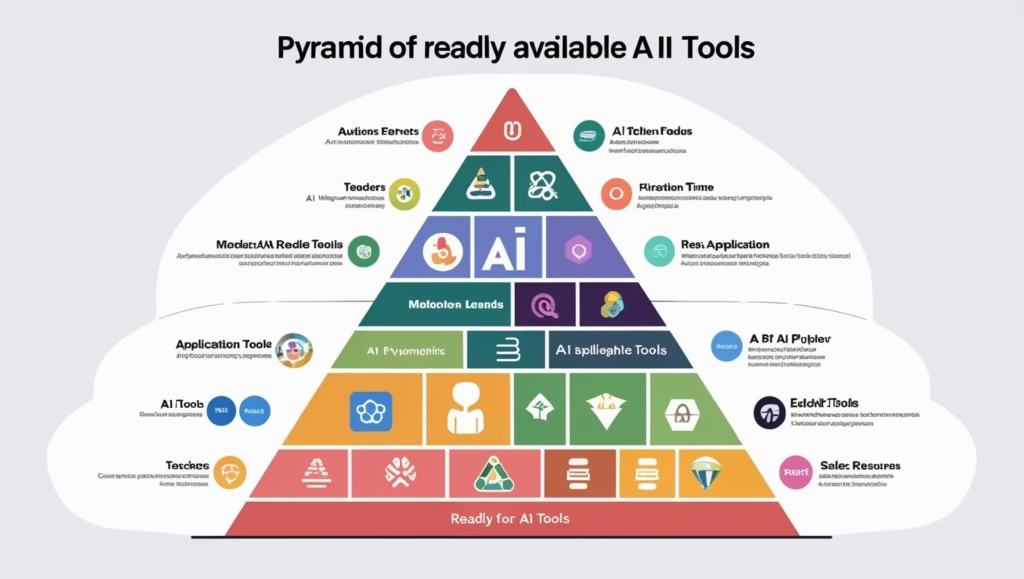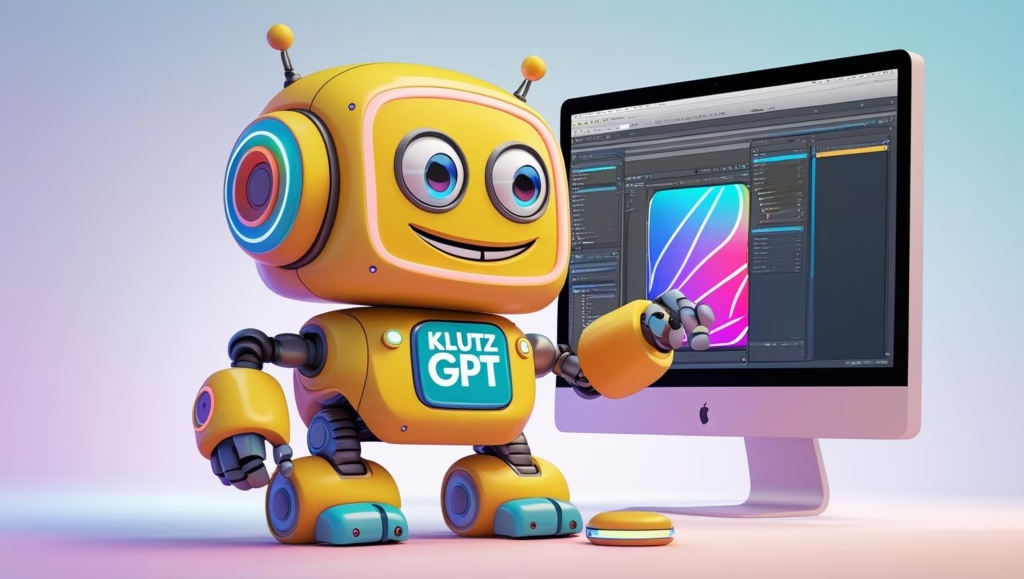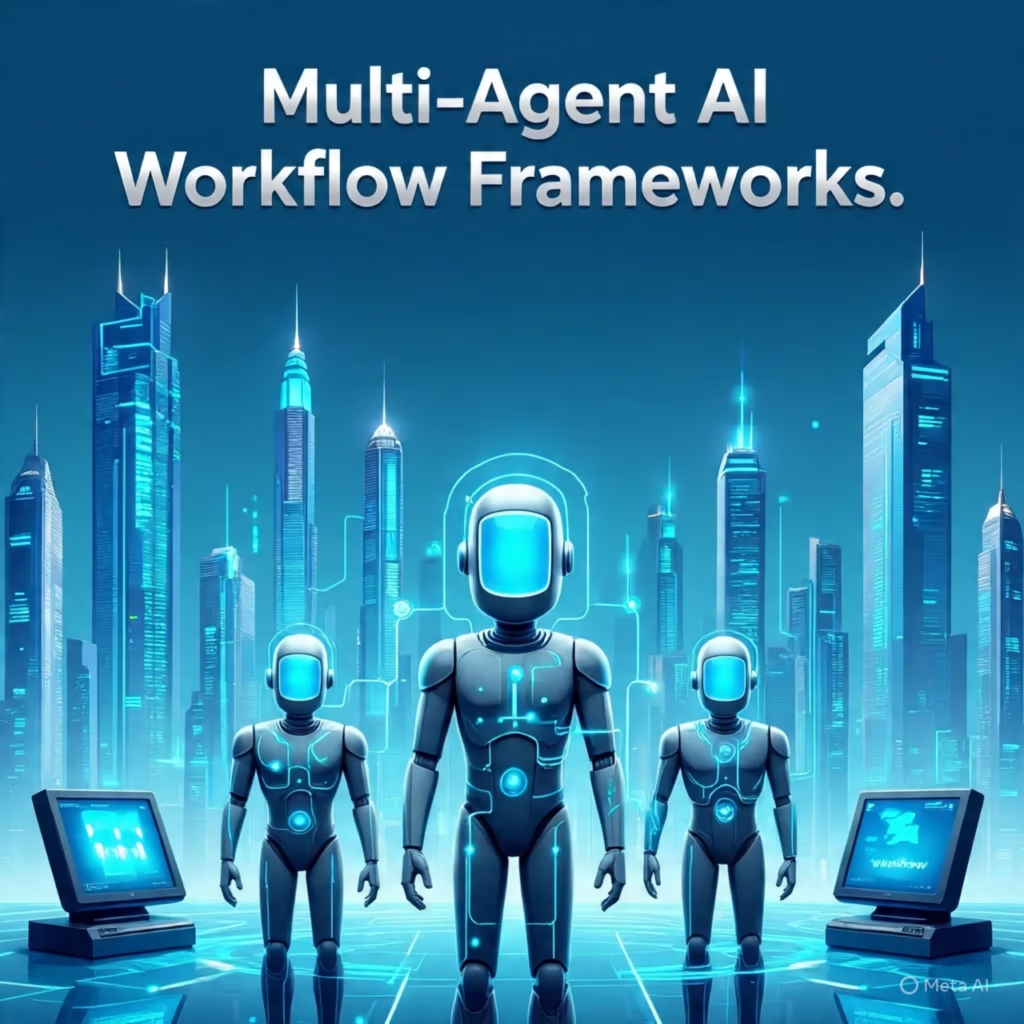The Ultimate Guide to the AI Tools : Top Productivity Platforms for 2025
Welcome to AiTechquest.com! If you’re a digital professional, creator, or tech enthusiast, you know the right tools can make or break your productivity. In 2025, the landscape of AI productivity tools has matured into a structured ecosystem beautifully captured in the AI Tools Pyramid. This guide unpacks each layer, highlights the best features and applications, and shows you how to combine these platforms for maximum impact.
Introduction: The AI Tools Pyramid and Its Relevance in 2025
The AI Tools Pyramid is more than a graphic; it’s a strategic framework for understanding the hierarchy and synergy of today’s top AI platforms. Each tier from code editors to image generators addresses a core need in the digital workflow. Whether you’re a developer, marketer, designer, or entrepreneur, the pyramid helps you identify the right tools for your goals and stack them for exponential productivity.
- Top tier: Specialized tools like AI code editors for technical users.
- Middle tiers: Market research and writing assistants for ideation and content.
- Base tiers: Design, video, customer service, and automation tools for execution and delivery.
Let’s climb the pyramid together!
Code Editor: Cursor
What Is Cursor?
Cursor sits at the apex, representing the new wave of AI-powered code editors. It leverages advanced AI to assist with code completion, debugging, and even generating complex algorithms from natural language prompts.
Best Features
- AI code suggestions and autocompletion
- Real-time debugging with contextual explanations
- Multi-language support
- Integration with Git and major IDEs
Real-World Applications
- Rapid prototyping
- Automated code reviews
- Learning new programming languages
Who Benefits Most?
- Developers, data scientists, and technical founders
Deep Dive
Cursor evolved from basic code assistants to a full-fledged coding partner. Its integration with cloud repositories and AI-driven refactoring sets it apart from traditional editors. Imagine writing, “Create a REST API in Python,” and having the boilerplate instantly generated!
Market Research: Perplexity & Gemini
What Are Perplexity and Gemini?
Perplexity and Gemini are leading market research AI tools. They transform raw data into actionable insights, helping you stay ahead in any industry.
Best Features
- Perplexity: Conversational search, real-time data aggregation, source citations
- Gemini: Google-powered research, trend analysis, visual data summaries
Real-World Applications
- Competitor analysis
- Consumer trend spotting
- Content ideation
Who Benefits Most?
- Marketers, strategists, entrepreneurs, and researchers
Deep Dive
Perplexity’s natural language interface makes research as easy as chatting. Gemini, backed by Google’s AI, excels at surfacing the latest trends and visualizing complex data.
Comparison:
Perplexity is ideal for conversational queries and citations, while Gemini shines for visual insights and integration with Google’s ecosystem.
Writing Assistants: ChatGPT, Claude, Grok
What Are ChatGPT, Claude, and Grok?
This tier powers the AI writing assistants that have revolutionized content creation. These tools generate, edit, and refine text for blogs, emails, marketing copy, and more.
Best Features
- ChatGPT: Versatile, context-aware, supports plugins and code interpretation
- Claude: Long-form content, business-friendly, privacy-focused
- Grok: Fast, witty responses, excels at creative writing
Real-World Applications
- Blog and article generation
- Email and proposal drafting
- Scriptwriting for video and podcasts
Who Benefits Most?
- Content creators, marketers, business professionals, educators
Deep Dive
ChatGPT, built by OpenAI, remains the most flexible, with plugin support and code execution. Claude, from Anthropic, is praised for its safety and handling of complex documents. Grok, from xAI, is the go-to for creative tasks and conversational copy.
Design Tools: Midjourney, Recraft, Figma, Canva
What Are These Design Tools?
This layer is the creative heart of the pyramid, featuring AI-powered design tools for graphics, UI/UX, and digital art.
Best Features
- Midjourney: Text-to-image generation, artistic style control
- Recraft: Vector art, logo design, AI-powered branding
- Figma: Collaborative UI/UX design, prototyping, real-time feedback
- Canva: Drag-and-drop design, templates, AI image editing
Real-World Applications
- Social media graphics
- App and website prototyping
- Brand identity creation
Who Benefits Most?
- Designers, marketers, startups, educators, agencies
Deep Dive
Midjourney is celebrated for its stunning, surreal art generation. Recraft is a favorite for branding and scalable vector graphics. Figma dominates UI/UX with real-time team collaboration. Canva democratizes design with its user-friendly interface and AI-powered tools.
Comparison:
Midjourney and Recraft specialize in original art; Figma and Canva are best for layouts and multi-user projects.
Essential Productivity Tools
RecCloud: Video Translation
- What it does: AI-powered video translation and subtitling
- Best features: Multi-language support, fast processing, accurate voice recognition
- Use cases: Global content distribution, e-learning, YouTube creators
Tidio: Customer Service
- What it does: AI chatbots and live chat for websites
- Best features: 24/7 support, integration with e-commerce, automated FAQs
- Use cases: E-commerce, SaaS, small business support
Zapier: Multi-Platform Automation
- What it does: Connects and automates workflows between 6,000+ apps
- Best features: No-code automation, robust triggers and actions, extensive integrations
- Use cases: Automating content publishing, syncing data, notifications
Calendly: Schedule Management
- What it does: AI-powered scheduling and meeting management
- Best features: Calendar sync, time zone detection, automated reminders
- Use cases: Client bookings, team meetings, webinars
PicWish: Image Generation
- What it does: AI image editing, background removal, upscaling
- Best features: Batch processing, one-click enhancements, creative filters
- Use cases: E-commerce product photos, marketing visuals, social media
Featured Tools Deep Dive
Cursor
- Background: Emerged as a leader in AI code editing by integrating deep learning with developer workflows.
- Innovations: Context-aware suggestions, code refactoring, bug detection.
- Example Workflow: “Refactor my JavaScript file for performance” Cursor analyzes and rewrites your code.
- Integrations: GitHub, VS Code, JetBrains IDEs.
Perplexity
- Background: Known for conversational research and source transparency.
- Innovations: Real-time web search, citation generation.
- Example Workflow: “Summarize the latest AI trends with sources” Perplexity delivers a concise, cited report.
- Integrations: Slack, Notion, Chrome extension.
Gemini
- Background: Google’s flagship AI for research and data analysis.
- Innovations: Visual data summaries, trend forecasting.
- Example Workflow: “Show me rising topics in fintech” Gemini creates charts and insights.
- Integrations: Google Workspace, Sheets, Docs.
ChatGPT
- Background: The most popular conversational AI, with millions of users worldwide.
- Innovations: Plugins, code interpreter, memory features.
- Example Workflow: “Draft a blog post outline about AI tools” ChatGPT generates a detailed structure.
- Integrations: Zapier, Slack, WordPress.
Claude
- Background: Built by Anthropic with a focus on safe, long-form content.
- Innovations: Handles large documents, privacy-first.
- Example Workflow: “Summarize this 50-page whitepaper” Claude delivers a digestible summary.
- Integrations: Google Drive, Notion.
Grok
- Background: Developed by xAI, known for witty and creative responses.
- Innovations: Fast, conversational, excels at brainstorming.
- Example Workflow: “Generate creative social media captions” Grok delivers catchy, on-brand copy.
- Integrations: Twitter/X, social media platforms.
Midjourney
- Background: Pioneered text-to-image AI art.
- Innovations: Artistic control, rapid iteration.
- Example Workflow: “Create a cyberpunk cityscape” Midjourney generates multiple unique images.
- Integrations: Discord, web app.
Recraft
- Background: Focuses on vector art and branding.
- Innovations: Logo generation, scalable graphics.
- Example Workflow: “Design a modern tech logo” Recraft outputs editable vector files.
- Integrations: Figma, Adobe Illustrator.
Figma
- Background: The go-to for UI/UX design.
- Innovations: Real-time collaboration, plugins.
- Example Workflow: “Prototype a mobile app interface” Figma enables team co-design.
- Integrations: Slack, Jira, Zapier.
Canva
- Background: Democratized design for non-designers.
- Innovations: AI-powered templates, magic resize, background remover.
- Example Workflow: “Create a YouTube thumbnail” Canva provides templates and instant edits.
- Integrations: Instagram, Facebook, Google Drive.
RecCloud
- Background: Leader in AI video translation.
- Innovations: Real-time subtitles, voice cloning.
- Example Workflow: “Translate my English video to Spanish” RecCloud adds accurate subtitles.
- Integrations: YouTube, Vimeo.
Tidio
- Background: AI customer service for websites.
- Innovations: Smart chatbots, e-commerce integration.
- Example Workflow: “Answer customer FAQs automatically” Tidio handles queries 24/7.
- Integrations: Shopify, WooCommerce, Messenger.
Zapier
- Background: The backbone of no-code automation.
- Innovations: Multi-app workflows, conditional logic.
- Example Workflow: “Post new blog articles to Twitter and Slack” Zapier automates the process.
- Integrations: 6,000+ apps.
Calendly
- Background: Simplifies scheduling for teams and individuals.
- Innovations: AI time suggestions, group scheduling.
- Example Workflow: “Let clients book calls based on my availability” Calendly syncs with calendars.
- Integrations: Google Calendar, Zoom, Microsoft Teams.
PicWish
- Background: AI for image editing and enhancement.
- Innovations: Batch background removal, upscaling.
- Example Workflow: “Remove backgrounds from 100 product images” PicWish does it in minutes.
- Integrations: Shopify, WooCommerce.
Practical Applications: Supercharging Productivity
Example Workflow:
A marketing team uses Perplexity for trend research, ChatGPT to draft content, Midjourney for custom visuals, Canva for final design, and Zapier to automate posting across platforms. Calendly manages client meetings, while Tidio handles customer queries.
Industry-Specific Uses:
- Marketing: Research with Gemini, content with Claude, visuals with Recraft, scheduling with Calendly.
- Design: Concepts in Midjourney, prototyping in Figma, assets in Canva, automation with Zapier.
- Customer Service: FAQs with Tidio, multilingual support with RecCloud, workflow automation with Zapier.
User Experiences and Testimonials
“Using ChatGPT and Midjourney together has cut my content creation time in half.” — Digital Marketer
“Zapier connects all my tools, so I never have to do repetitive tasks manually.” — Startup Founder
“With Figma and Canva, our remote design team collaborates faster than ever.” — UI/UX Designer
Limitations and Considerations
- Learning Curve: Some tools require onboarding and experimentation.
- Privacy: Always check data policies, especially with sensitive content.
- Pricing: Many tools offer free tiers, but advanced features may require subscriptions.
- Integration Issues: Not all tools play nicely together; test your stack before scaling.
Tips for Maximizing Productivity
- Start with your workflow: Identify bottlenecks, then select tools that address them.
- Combine tools: Use Zapier to automate tasks between platforms.
- Stay updated: AI tools evolve rapidly—follow AiTechquest.com for the latest.
- Leverage communities: Join forums and Discords for tips and templates.
Comparison Table
| Tool | Main Features | Pricing | Ideal Users |
|---|---|---|---|
| Cursor | AI code editing, debugging | Free/Paid | Developers |
| Perplexity | Conversational research, citations | Free/Paid | Marketers, Researchers |
| Gemini | Trend analysis, data visualization | Free/Paid | Strategists, Analysts |
| ChatGPT | Text generation, plugins | Free/Paid | Creators, Businesses |
| Claude | Long-form, privacy-focused | Free/Paid | Professionals |
| Grok | Creative writing, fast responses | Free/Paid | Marketers, Writers |
| Midjourney | AI art, style control | Paid | Designers, Artists |
| Recraft | Vector art, branding | Free/Paid | Branding, Designers |
| Figma | UI/UX, collaboration | Free/Paid | Designers, Teams |
| Canva | Templates, AI editing | Free/Paid | Marketers, Educators |
| RecCloud | Video translation, subtitles | Free/Paid | Content Creators |
| Tidio | AI chatbots, customer service | Free/Paid | E-commerce, SMBs |
| Zapier | Workflow automation | Free/Paid | All professionals |
| Calendly | Scheduling, reminders | Free/Paid | Teams, Freelancers |
| PicWish | Image editing, upscaling | Free/Paid | E-commerce, Creators |
Future Trends
- Deeper integrations: Expect even more seamless connections between AI tools.
- Personalized AI: Tools will adapt to your preferences and workflows.
- Voice and multimodal AI: More platforms will support voice, video, and image input/output.
- Greater accessibility: Democratization of advanced features for non-technical users.
Conclusion: Explore the AI Tools Pyramid!
The AI Tools Pyramid is your roadmap to mastering productivity in 2025. By understanding each tier and combining the right platforms, you can automate, create, and innovate like never before.
Ready to transform your workflow?
Explore these tools, experiment with combinations, and share your experiences in the comments below. For more deep dives, tutorials, and the latest AI trends, bookmark AiTechquest.com.
Related Resources:
Let’s build the future—one AI tool at a time!
Keywords: AI productivity tools, best AI apps 2025, AI workflow automation, AI for creators, AI-powered design tools, market research AI, AI writing assistants, AI customer service tools, AI tools for business, AI content creation, AI image generation, AI video tools, automation tools 2025, top AI platforms, ChatGPT alternatives, Midjourney AI, Zapier automation, Figma AI, Canva AI, Gemini AI, Claude AI, AI tools for marketers, AI tools for developers, AI tools for designers, AI-powered productivity, digital transformation AI
Disclaimer: Transparency is important to us! This blog post was generated with the help of an AI writing tool. Our team has carefully reviewed and fact-checked the content to ensure it meets our standards for accuracy and helpfulness. We believe in the power of AI to enhance content creation, but human oversight is essential.





